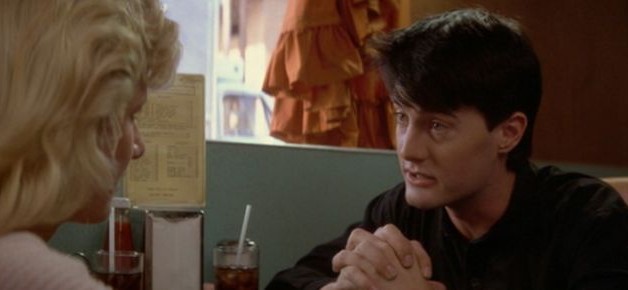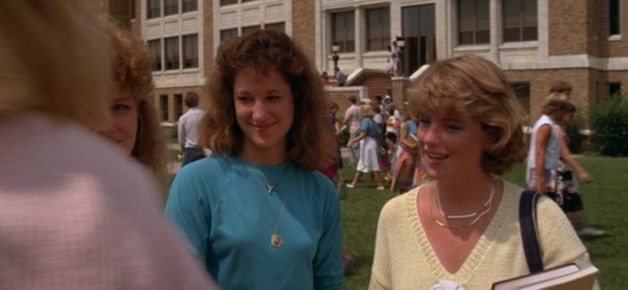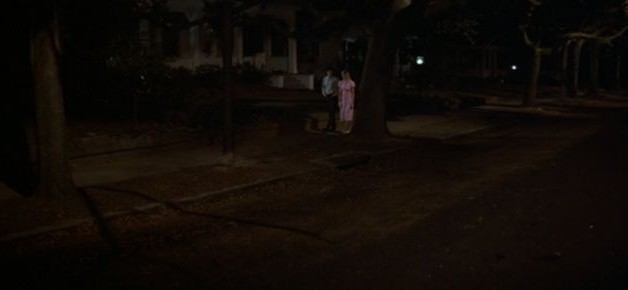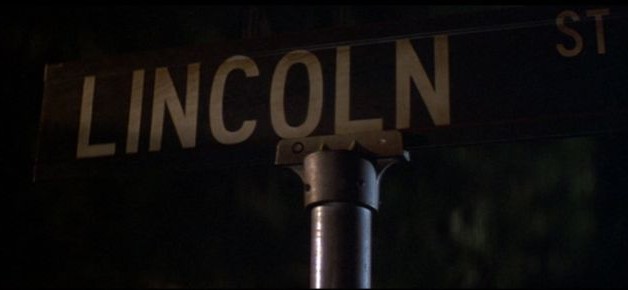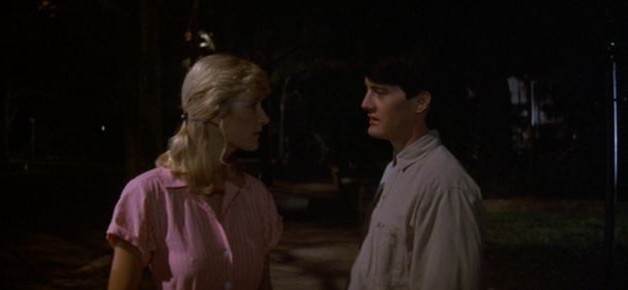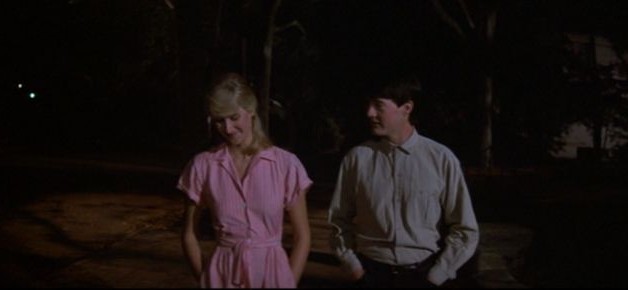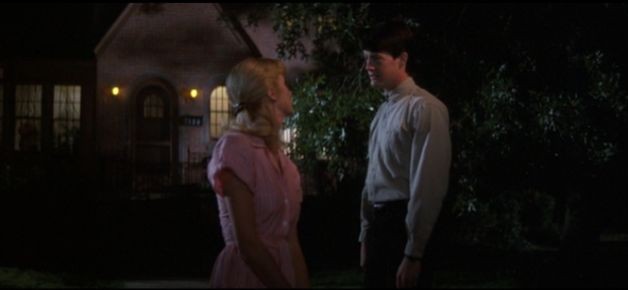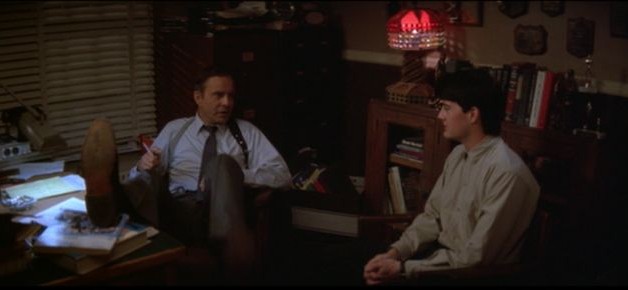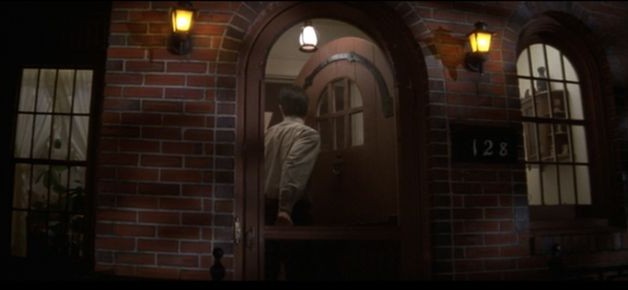The Blue Velvet Project
Blue Velvet, 47 seconds at a time by Nicholas Rombes
-
 The Blue Velvet Project, #23
The Blue Velvet Project, #23
Second #1081, 18:01 “There are opportunities in life for gaining knowledge and experience,” Jeffrey has just said to Sandy as they sit in Arlene’s. In 1844, two years after his eldest son died of scarlet fever, Ralph Waldo Emerson began his most radical essay, “Experience,” with these sentences: “Where do we find ourselves? In a series of which we do not know the extremes, and believe that it has none. We wake and find ourselves on a stair; there are stairs below us, which we seem to have ascended; there are stairs above us, many a one, which go upward… Read more
-
 The Blue Velvet Project, #22
The Blue Velvet Project, #22
Second #1034, 17:14 The beauty of hair in the mid-Eighties, curling ironed and a little bit feathered. Sandy’s friends are trapped somewhere between 1956 and 1986, in their long skirts and sweaters. “Don’t you guys dare say anything to Mike, okay?” Sandy warns them, as Jeffrey waits for her in his classic red Oldsmobile convertible. “It’s not what you think, okay? Promise?” For all its references to the past—especially in this scene—Blue Velvet resists the lure of nostalgia. In the best and most obscurely written book ever on postmodernism, Fredric Jameson argued that realism itself was the casualty of late… Read more
-
 The Blue Velvet Project, #21
The Blue Velvet Project, #21
Second #987, 16:27 1. Double Ed to Jeffrey: “If you want to spray for bugs Jeffrey, it causes us no pain.” 2. “The black tradition is double-voiced.” (Henry Louis Gates, Jr., from The Signifying Monkey: A Theory of African-American Literary Criticism) 3. Valvoline. 4. Comet. 5. A “Danger” sign. 6. The backroom of a hardware store might be said to be a particularly American place, one whose codes are so obvious they are practically inscrutable. 7. The image at second #987 exists on the level of folklore. 8. One of the Eds is blind; the other sees for him. 9.… Read more
-
 The Blue Velvet Project, #20
The Blue Velvet Project, #20
Second #940, 15:40 “That’s kind of interesting,” Sandy says, laughing, after Jeffrey has—out of the blue—demonstrated the chicken walk. Blue Velvet was the last Lynch film on which Alan Splet designed sound and in this scene, like so many others, it’s as if we are enveloped in an auditory cocoon. “Sound is very important,” Lynch has said, “because it really is half the film. With film, the whole can be greater than the parts if you have the sound, the image, and sequence of scenes right.” At right around second #940, the film cuts to this shot, and the sound… Read more
-
 The Blue Velvet Project, #19
The Blue Velvet Project, #19
Second #893, 14:53 In the early days of silent cinema, text and image coexisted, as intertitles directed viewers how to read a film, literally. In the best of these films, intertitles not only conveyed narrative information, but suggested possibilities of reading that allowed for the viewer to construct her own meaning from the relationship between text and image. In Blue Velvet, the LINCOLN street sign, which functions almost like an insert shot, is its own form of postmodern intertitle. [Christian Metz: “When approaching cinema from the linguistic point of view, it is difficult to avoid shuttling back and forth between… Read more
-
 The Blue Velvet Project, #18
The Blue Velvet Project, #18
Second #846, 14:06 They have walked together in the night for several minutes now, delicately circling the topic of evil, as if talking in code. Finally, Jeffrey takes a gamble: “I, uh, guess you gotta get back home pretty soon, huh?” he asks Sandy. Her reply, as usual, takes the form of another question: “Not really—why?” And then she offers to show him Dorothy Vallens’s apartment, whose weak gravity has been slowly pulling them closer. This is a fiercely political stretch of the film, given the context of Ronald Reagan and his elevation of family to mythic status. In his… Read more
-
 The Blue Velvet Project, #17
The Blue Velvet Project, #17
Second #799, 13:19 “Jeffrey can connect different worlds,” David Lynch has said. “He can look into Sandy’s world, he can look into Dorothy’s world, he can get into Frank’s world.” The secret subtext to this scene is Life Begins for Andy Hardy (1941), starring Mickey Rooney and Judy Garland, number 11 in the movie series, where Andy learns that adult life is dark and impure and trip-wired with temptation and so struggles mightily to gear-shift his life into reverse. Andy, in New York, away from his future wife Betsy Booth (Judy Garland), is tempted by the “wolfess” Jennifer Hicks (Patricia… Read more
-
 The Blue Velvet Project, #16
The Blue Velvet Project, #16
Second #752, 12:52 1. Jeffrey has just left the Williams’s, when their daughter Sandy appears slowly out of the shadows, to the swelling of music and the sound of wind moving through the tree branches, in one of the most remarkable entrances in cinema history, asking him, “Are you the one that found the ear?” 2. “How did you know?” Jeffrey says. “I just know. That’s all,” Sandy replies, in her pink dress, with no bra. The frame is overheated with information about light, and Sandy’s face, the way it is turned to Jeffrey, it’s as if she wants him… Read more
-
 The Blue Velvet Project, #15
The Blue Velvet Project, #15
Second #705, 11:45 And so here you are, lost in a movie. “It must be great,” the young man says to the older man, referring to his job as a detective. The older man replies, “It’s horrible too.” And you think: this is how life is. Great. And horrible. The detective is at work eradicating evil all the time, even at home where he has not changed out of his detective outfit, because evil does not sleep. You think about the seriousness with which Blue Velvet treats evil in a secular age, and how the most that the detective can… Read more
-
 The Blue Velvet Project, #14
The Blue Velvet Project, #14
Minute #658, 7:58 1. Jeffrey, entering the Williams’s home, crossing a threshold that is a doorway. This is Sandy’s castle, guarded by her father the detective, who wears his gun holstered, even at home. Or is Jeffrey the detective? Or—more radically—is Sandy? 2. “Leaving the burning theater behind one begins to ease into a new perspective. The stairway leads to a doorway, the doorway to an alleyway, the alleyway to another door, more stairs, another amber room where one can forget again” 3. “He hacks desperately at the brambles and, as the hedge closes round him like the grasping flesh-raking… Read more
